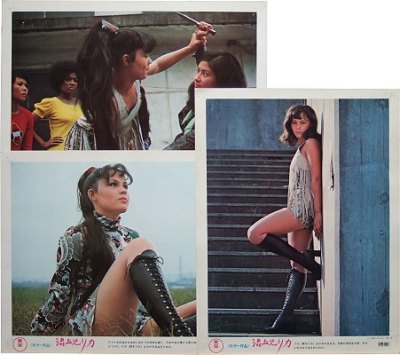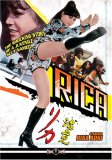| Reviews & Columns |
|
Reviews DVD TV on DVD Blu-ray 4K UHD International DVDs In Theaters Reviews by Studio Video Games Features Collector Series DVDs Easter Egg Database Interviews DVD Talk Radio Feature Articles Columns Anime Talk DVD Savant Horror DVDs The M.O.D. Squad Art House HD Talk Silent DVD
|
DVD Talk Forum |
|
|
| Resources |
|
DVD Price Search Customer Service #'s RCE Info Links |
|
Columns
|
|
|
Rica
Rica Aoki (Rika Aoki)** is a mixed-race juvenile delinquent whose Japanese mother (Sotomi Kotake in flashbacks, Kazuko Imai in present-day scenes) was raped by American G.I.s during the American Occupation. As the film opens, Rica watches helplessly as a fellow member of her girl-gang, having been raped by Hiroshi (Goro Daimon) of the Tachibana Gang some time before, miscarries after drinking poison in a suicide attempt. Rica delivers the dead fetus to Hiroshi, who later shows up with his gang to have it out with Rica. In the melee Hiroshi is accidentally killed, and Rica is shipped off to a Christian reform school. Meanwhile, the rest of Rica's gang are raped and sold as sex slaves for American servicemen in Vietnam.
Rica eventually escapes from the reformatory, hoping to buy or otherwise get her gangbanger girlfriends back, but is constantly betrayed by various gangsters who're only interesting in laying her. Meanwhile, a mysterious man named Tetsu (Fuminori Sato) acts as Rica's guardian angel, ready to help out and rescue her when she's in a jam.
A veritable catalog of "pinky violence" sex and action, Rica delivers with generous reel quotas of artery-bursting violence and (intended) titillating sexual assault in nearly every scene. Rica, as likely to sucker-punch her opponents as pound them with karate chops, is similarly handy and unhesitant with knives and, early in the film, even pulls a "Moe Howard," poking bald baddie Hiroshi's eyes out. Unfortunately, Rica doesn't remotely have the ultimately feminist appeal of the Shunya Ito / Meiko Kaji Female Convict Scorpion films, made at Toei at about the same time, nor does Aoki have the moves or charm of, say, Etsuko "Sue" Shihomi in that actress's Sister Streetfighter films.
Indeed, Aoki isn't much of a talent at all and it's no surprise that beyond her three Rika movies she appeared in just one other film (Toei's Student Yakuza, 1974) before vanishing all together. She's somewhat exotic looking but not particularly attractive, and though she looks tough she's not athletic like Shihomi and her fight scenes aren't convincing. (Some of the fight scenes are under-cranked to compensate for Aoki's lethargic moves.) At one point she's seen - clothed - performing in a strip club, but she can't even dance well. Most of the young leads, including Sato and Kazuko Nagamoto (not bad as Reiko, Rica's reformatory rival) did few if any other films.
The film's anti-Americanism is more fashionable than political, with American serviceman either savage brutes or sympathetic deserters trying to escape the battlefields of Vietnam. Nakahira and Shindo each had intelligently addressed American exploitation of ordinary Japanese in their movies (Nakahira in Crazed Fruit, Shindo in The Lucky Dragon No. 5, to name but two), but here it functions as little beyond a means to jerk along the absurd plotting and frequent unbelievable coincidences. The foreign (and amateur) actors in these roles, all of whom go unbilled, are unilaterally terrible.
Rica's mixed-race status is little more than a gimmick. It's generally addressed only indirectly: the way, for instance, various men find her irresistibly, exotically attractive (though Aoki isn't, particularly). As a character, Rica never talks about it nor are there scenes showing anything like Rica being discriminated by mainstream society, mainly because she spends virtually the entire film among gangsters and lowlifes, or at the reformatory.
After making his impressive directorial debut with Crazed Fruit, Nakahira was assigned increasingly routine pictures at his home studio, Nikkatsu, where he made two-to-four per year until 1966. After that he began making movies for the Shaw Bros. in Hong Kong. In 1970 he began releasing his movies through Toho, and starting with Chimimoryo: A Soul of Demons (Yami no naka no Chimimoryo, 1971) Nakahira renewed his association with screenwriter-director Shindo, who wrote many of Nakahira's early works.
Shindo ended up penning all three Rica movies, and all were co-produced through his production company, Kindai Eiga Kyokai. Though his credits as a director are perfectly respectable, he was not averse to whoring out his talents as a screenwriter, and during the '70s and '80s especially he wracked up some disreputable credits worthy of Stirling Silliphant, though it impacted the respectable side of his career not at all. (Indeed, at 95, Shindo is currently busy promoting his latest movie; he wrote the story and screenplay for The Battleship on the Ground, released just last month.)
Video & Audio
Rica is presented in a fine if moderately grainy 16:9 enhanced transfer that retains the film's original CinemaScope screen shape. ("Toho Scope" is billed on the box, but the studio officially dropped the name after 1967.) The Dolby Digital mono audio, in Japanese only with optional English subtitles, is fine, as are the subtitles themselves. Happily, complete credits in English follow the feature presentation.
Extra Features
Supplements include a nice Stills Gallery, actually a collection of Japanese lobby cards and a Toho International brochure that has been formatted so that interested viewers can read all the text.
Also included are Japanese Trailers, all 16:9 enhanced and subtitled, for Rica and its two sequels: Rica - Lonely Wanderer and Rica - Juvenile's Lullaby (both 1973). All three films were released less than seven months apart.
Parting Thoughts
Criticisms aside, Rica undeniably is entertaining due to its sheer audaciousness and political incorrectness. Fans of such pictures will find it entertaining if unexceptional beyond its central gimmick.
** Aoki's first name definitely is Rika, not Rica, in the strict Japanese reading. Rica was Toho's original international title for the film.
Film historian Stuart Galbraith IV's most recent essays appear in Criterion's three-disc Seven Samurai DVD and BCI Eclipse's The Quiet Duel. His audio commentary for Invasion of Astro Monster is now available.
|
| Popular Reviews |
| Sponsored Links |
|
|
| Sponsored Links |
|
|
| Release List | Reviews | Shop | Newsletter | Forum | DVD Giveaways | Blu-Ray | Advertise |
|
Copyright 2024 DVDTalk.com All Rights Reserved. Legal Info, Privacy Policy, Terms of Use,
Manage Preferences,
Your Privacy Choices | |||||||














